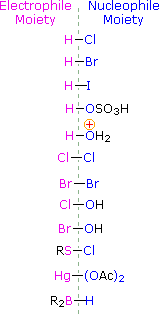


 علم الكيمياء
علم الكيمياء 
 الكيمياء التحليلية
الكيمياء التحليلية 
 الكيمياء الحياتية
الكيمياء الحياتية 
 الكيمياء العضوية
الكيمياء العضوية 
 الكيمياء الفيزيائية
الكيمياء الفيزيائية
 الكيمياء اللاعضوية
الكيمياء اللاعضوية 
 مواضيع اخرى في الكيمياء
مواضيع اخرى في الكيمياء
 الكيمياء الصناعية
الكيمياء الصناعية |
Read More
Date: 21-12-2015
Date: 12-7-2018
Date: 22-9-2019
|
The proton is not the only electrophilic species that initiates addition reactions to the double bond of alkenes. Lewis acids like the halogens, boron hydrides and certain transition metal ions are able to bond to the alkene pi-electrons, and the resulting complexes rearrange or are attacked by nucleophiles to give addition products.The electrophilic character of the halogens is well known. Chlorine (Cl2) and bromine(Br2) react selectively with the double bond of alkenes, and these reactions are what we will focus on. Fluorine adds uncontrollably with alkenes,and the addition of iodine is unfavorable, so these are not useful preparative methods.
The addition of chlorine and bromine to alkenes, as shown below, proceeds by an initial electrophilic attack on the pi-electrons of the double bond. Dihalo-compounds in which the halogens are bound to adjacent carbons are called vicinal, from the Latin vicinalis, meaning neighboring.
R2C=CR2 + X2 ——> R2CX-CR2X
Other halogen-containing reagents which add to double bonds include hypohalous acids, HOX, and sulfenyl chlorides, RSCl. These reagents are unsymmetrical, so their addition to unsymmetrical double bonds may in principle take place in two ways. In practice, these addition reactions are regioselective, with one of the two possible constitutionally isomeric products being favored. The electrophilic moiety in both of these reagents is the halogen.
(CH3)2C=CH2 + HOBr ——> (CH3)2COH-CH2Br
(CH3)2C=CH2 + C6H5SCl ——> (CH3)2CCl-CH2SC6H5
The regioselectivity of the above reactions may be explained by the same mechanism we used to rationalize the Markovnikov rule. Thus, bonding of an electrophilic species to the double bond of an alkene should result in preferential formation of the more stable (more highly substituted) carbocation, and this intermediate should then combine rapidly with a nucleophilic species to produce the addition product.


To apply this mechanism we need to determine the electrophilic moiety in each of the reagents. By using electronegativity differences we can dissect common addition reagents into electrophilic and nucleophilic moieties, as shown on the right. In the case of hypochlorous and hypobromous acids (HOX), these weak Brønsted acids (pKa's ca. 8) do not react as proton donors; and since oxygen is more electronegative than chlorine or bromine, the electrophile will be a halide cation. The nucleophilic species that bonds to the intermediate carbocation is then hydroxide ion, or more likely water (the usual solvent for these reagents), and the products are called halohydrins. Sulfenyl chlorides add in the opposite manner because the electrophile is a sulfur cation, RS(+), whereas the nucleophilic moiety is chloride anion (chlorine is more electronegative than sulfur).
Below are some examples illustrating the addition of various electrophilic halogen reagents to alkene groups. Notice the specific regiochemistry of the products, as explained above.



|
|
|
|
تفوقت في الاختبار على الجميع.. فاكهة "خارقة" في عالم التغذية
|
|
|
|
|
|
|
أمين عام أوبك: النفط الخام والغاز الطبيعي "هبة من الله"
|
|
|
|
|
|
|
قسم شؤون المعارف ينظم دورة عن آليات عمل الفهارس الفنية للموسوعات والكتب لملاكاته
|
|
|